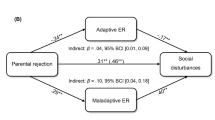Abstract
Objectives
This study examined the associations between emotional availability (EA) and mindful parenting (MP), as well as their independent and combined associations with indicators of adolescent well-being. EA is a well-established measure of parent-child relationship quality and conceptualized to be a life-span measure of emotional connection in relationships. Thus far, the EA literature spans pregnancy to middle childhood. The current study extends the concept into the adolescence. MP is a construct shown to be associated with both positive parent-child relationships and adolescent well-being.
Methods
The current study tests the association among EA, MP, and indicators of adolescent well-being in a sample of 30 mother-adolescent dyads (adolescent ages 10-14 years). EA and MP were assessed through observational coding of parent-adolescent interactions.
Results
Results indicated significant associations between EA and MP, and between each construct and adolescent outcomes. The strongest correlations were found between global scores of MP and EA (.53), and between MP subscales and the EA Scales of sensitivity (0.44-0.56) and structuring (0.48-0.59). One EA scale, adult nonhostility, and one MP scale, nonjudgmental acceptance of self and child, were significant predictors of parent-reported adolescent externalizing problems, independently and after accounting for the other (p < 0.05).
Conclusions
These results indicate there are significant relations between EA and MP and both constructs are related to adolescent outcomes, with some specific contributions to indicators of adolescent well-being.

Similar content being viewed by others
References
Achenbach, T. M., & Rescorla, L. A. (2001). Manual for the ASEBA School-Age Forms & Profiles. Burlington, VT: University of Vermont, Research Center for Children, Adolescent, & Families.
Allen, J. P., Porter, M., McFarland, C., McElhaney, K. B., & Marsh, P. (2007). The relation of attachment security to adolescents' paternal and peer relationships, depression, and externalizing behavior. Child Development, 78, 1222–1239. https://doi.org/10.1111/j.1467-8624.2007.01062.x.
Altenhofen, S., Sutherland, K., & Biringen, Z. (2010). Families experiencing divorce: age at onset of overnight stays, conflict, and emotional availability as predictors of child attachment. Journal of Divorce and Remarriage, 51(3), 141–156.
Barnes, S., Brown, K. W., Krusemark, E., Campbell, W. K., & Rogge, R. D. (2007). The role of mindfulness in romantic relationship satisfaction and responses to relationship stress. Journal of Marital and Family Therapy, 33, 482–500. https://doi.org/10.1111/j.1752–0606.2007.00033.x.
Biringen, Z. (2005). Training and reliability issues with the Emotional Availability Scales. Infant Mental Health Journal, 26, 404–405.
Biringen, Z. (2008). The Emotional Availability (EA) Scales Manual. 4th edition, MiddleChildhood/Adolescent Version. Boulder, CO: emotionalavailability.com.
Biringen, Z., Derscheid, D., Vliegen, N., Closson, L., & Easterbrooks, M. A. (2014). Emotional availability (EA): theoretical background, empirical research using the EA Scales, and clinical applications. Developmental Review, 34, 114–167. https://doi.org/10.1016/j.dr.2014.01.002.
Bornstein, M. H., Gini, M., Putnick, D. L., Haynes, O. M., Painter, K. M., & Suwalsky, J. D. (2006). Short-term reliability and continuity of emotional availability in mother-child dyads across contexts of observation. Infancy, 10(1), 1–16. https://doi.org/10.1207/s15327078IN1001_1.
Bowlby, J. (1983). Attachment and Loss: Attachment 1, New York: Basic Books.
Bradley, S. (2013). Adolescent agency: a conceptual model, measurement, and construct validity. State College, PA: The Pennsylvania State University (unpublished doctoral dissertation).
Brown, K. W., & Ryan, R. M. (2003). The benefits of being present: mindfulness and its role in psychological well-being. Journal of Personality and Social Psychology, 84(4), 822–848.
Brown, K. W., Ryan, R. M., & Creswell, J. D. (2007). Mindfulness: theoretical foundations and evidence for its salutary effects. Psychological Inquiry, 18, 211–237. https://doi.org/10.1080/10478400701598298.
Bryan, M. G., Coatsworth, J. D., & Greenberg, M. T. (2016). The mindful parenting observational scales (MPOS): Theoretical background and preliminary evidence for inter-rater reliability and incremental validity. Fort Collins, CO: The Colorado State University.
Coatsworth, J. D., Duncan, L. G., Greenberg, M. T., & Nix, R. L. (2010). Changing parent’s mindfulness, child management skills and relationship quality with their adolescent: Results from a randomized pilot intervention trial. Journal of Child and Family Studies, 19, 203–217. https://doi.org/10.1007/s10826-009-9304-8.
Coatsworth, J. D., Duncan, L. G., Nix, R. L., Greenberg, M. T., Gayles, J. G., Bamberger, K. T., & Demi, M. A. (2015). Integrating mindfulness with parent training: Effects of the mindfulness-enhanced strengthening families program. Developmental Psychology, 51(1), 26–35. https://doi.org/10.1037/a0038212.
Cohen, J. S., & Semple, R. J. (2010). Mindful parenting: a call for research. Journal of Child and Family Studies, 19(2), 145–151. https://doi.org/10.1007/s10826-009-9285-7.
Collins, A. W., Laursen, B., Mortensen, N., Luebker, C., & Ferreira, M. (1997). Conflict processes and transitions in parent and peer relationships: Implications for autonomy and regulation. Journal of Adolescent Research, 12, 178–198.
Duncan, L. G., Coatsworth, J. D., & Greenberg, M. T. (2009). A model of mindful parenting: Implications for parent–child relationships and prevention research. Clinical Child and Family Psychology Review, 12, 255–270. https://doi.org/10.1007/s10567-009-0046-3.
Easterbrooks, M. A., Bureau, J., & Lyons-Ruth, K. (2012). Developmental correlates and predictors of emotional availability in mother–child interaction: A longitudinal study from infancy to middle childhood. Development and Psychopathology, 24(1), 65–78. https://doi.org/10.1017/S0954579411000666.
Forehand, R., Jones, D. J., & Parent, J. (2013). Behavioral parenting interventions for child disruptive behaviors and anxiety: what's different and what's the same. Clinical Psychology Review, 33(1), 133–145. https://doi.org/10.1016/j.cpr.2012.10.010.
Geier, M. H., Coatsworth, J. D., Turksma, C., & Greenberg, M. T. (2012). The Mindful Parenting Rating Scales Coding Manual. State College, PA: The Strengthening Families in Pennsylvania Project, Department of Health and Human Development, The Pennsylvania State University.
Guarnieri, S., Smorti, M., & Tani, F. (2015). Attachment relationships and life satisfaction during emerging adulthood. Social Indicators Research, 121, 833–847.
Harnett, P. H., & Dawe, S. (2012). The contribution of mindfulness-based therapies for children and families and proposed conceptual integration. Child and Adolescent Mental Health, 17, 195–208. https://doi.org/10.1111/j.1475-3588.2011.00643.x.
Howes, C., & Hong, S. S. (2008). Early emotional availability: predictive of pre-kindergarten relationships among Mexican-heritage children? Journal of Early Childhood and Infant Psychology, 4, 44–25.
Huebner, E. S. (1991). Initial development of the students' life satisfaction scale. School Psychology International, 12, 231–240.
Huebner, E. S., Suldo, S. M., & Valois, R. F. (2003). Psychometric properties of two brief measures of Children’s Life Satisfaction: The Students’ Life Satisfaction Scale (SLSS) and the brief multidimensional Students’ Life Satisfaction Scale (BMSLSS). Paper presented at the Indicators of Positive Development Conference, University of South Carolina.
Johnson, M. D., & Galambos, N. L. (2014). Paths to intimate relationship quality from parent–adolescent relations and mental health. Journal of Marriage and Family, 76, 145–160.
Kogan, N., & Carter, A. S. (1996). Mother–infant reengagement following the still-face: The role of maternal emotional availability in infant affect regulation. Infant Behavior and Development, 19, 359–370. https://doi.org/10.1016/S0163-6383(96)90034-X10.1111/jomf.12074.
Lippold, M. A., Duncan, L. G., Coatsworth, J. D., Nix, R. L., & Greenberg, M. T. (2015). Understanding how mindful parenting may be linked to mother–adolescent communication. Journal of Adolescent and Adolescence, 44, 1663–1673. https://doi.org/10.1007/s10964-015-0325-x.
McClain, D. B., Wolchik, S. A., Winslow, E., Tein, J.-Y., Sandler, I. N., & Millsap, R. E. (2010). Developmental cascade effects of the New Beginnings Program on adolescent adaptation outcomes. Development and Psychopathology, 22, 771–784. https://doi.org/10.1017/S0954579410000453.
McWey, L. M., Claridge, A. M., Wojciak, A. S., & Lettenberger‐Klein, C. G. (2015). Parent–adolescent relationship quality as an intervening variable on adolescent outcomes among families at risk: dyadic analyses. Family Relations: An Interdisciplinary Journal of Applied Family Studies, 64, 249–262. https://doi.org/10.1111/fare.12111.
Melby, J. N., Conger, R. D., Book, R. A., Rueter, M., Lucy, L., Repinski, D., Ahrens, K., Black, D., Brown, D., Huck, S., Mutchler, L., Rogers, S., Ross, J., & Stavros, T. (1989). The Iowa Family Interaction Coding Manual. Ames, IA: Iowa Adolescent and Families Project, Department of Sociology, Iowa State University.
Parent, J., McKee, L. G., Rough, J., & Forehand, R. (2016). The association of parent mindfulness with parenting and youth psychopathology across three developmental stages. Journal of Abnormal Child Psychology, 44(1), 191–202. https://doi.org/10.1007/s10802-015-9978-x.
Authors’ contributions
J.B. designed and executed the study, E.A. coding, assisted with the data analyses, and wrote the paper. J.D.C. collaborated with the design, M.P. coding, data analysis, and writing of the study. Z.B. collaborated with the design, E.A. coding training, and writing of the study.
Author information
Authors and Affiliations
Corresponding author
Ethics declarations
Conflict of interest
J.B. and D.J.C. declare that they have no conflict of interest. Z.B. has disclosed a potential financial conflict of interest because she developed the emotional availability (EA) system used in this paper and potentially stands to gain from favorable findings. Because of this potential, she voluntarily distances herself from evaluation and reporting activities (e.g. primary data handling, analysis, and sole control over reporting results) and has a conflict of interest management plan supervised by Colorado State University.
Additional information
Publisher’s note: Springer Nature remains neutral with regard to jurisdictional claims in published maps and institutional affiliations.
Rights and permissions
About this article
Cite this article
Benton, J., Coatsworth, D. & Biringen, Z. Examining the Association Between Emotional Availability and Mindful Parenting. J Child Fam Stud 28, 1650–1663 (2019). https://doi.org/10.1007/s10826-019-01384-x
Published:
Issue Date:
DOI: https://doi.org/10.1007/s10826-019-01384-x




